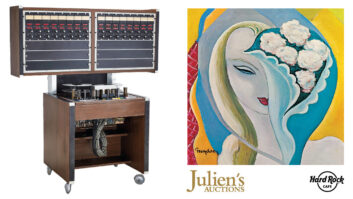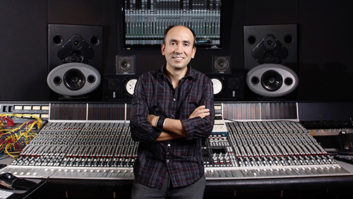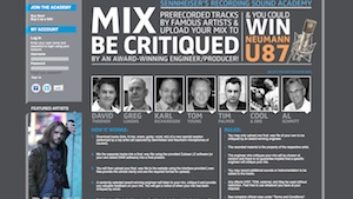We were bouncing and submixing all of this stuff every step of the way. And we wanted each part perfect, so it became a very punched-in world we lived in.
Each of us knew what the others were good at, and we let each other do those things. The result was hit records.
I have no idea what it’s like to be in the studio with Karl Richardson. But I do know what it’s like to be out on a fishing boat with him, five miles off of the Miami coast, looking for a different kind of hit. Waiting his turn in the chair rig, Richardson is quiet. He watches what happens during others’ stints with the big tackle, with its lines connected to kites trailing the boat to give the bait a wider range. He pulls on an occasional Merit Ultra Light, and it’s clear he’s having fun, but he rarely seems truly relaxed. He joins in the banter with his once and future cohorts, Ron and Howie Albert, whom he preceded in their long, collective stints at Miami’s Criteria Recording Studios, and singer/producer/TV show host (Where the Action is) Steve Alaimo. All four of them are now partners in Audio Vision Studios, a few miles away from the now rehabilitated and renovated Criteria in northeastern Dade County.
Including Richardson’s contributions — which include engineering and/or producing records for the Bee Gees (including “Stayin’ Alive”), Kenny Rogers (the multi-Platinum “Islands in the Stream” with Dolly Parton), Barbra Streisand (“Guilty”), Eric Clapton (461 Ocean Boulevard), the Ohio Players and Olivia Newton-John — the Platinum quotient of this fishing expedition is approaching 200 million units. But in the end, Richardson is satisfied with a 15-pound dolphin that takes about 20 minutes to land (and gets thrown back).
Richardson was born in Philadelphia, but grew up in south Florida, where he still lives. He attended Citrus Grove Elementary School and North Miami High and had an adolescence that could have been found in the Cleavers’ home — if Ward and June had let the Beaver have a garage band.
“It was great growing up down here,” he says. “I got my first job doing live sound at the old World Dance Hall in north Miami, and I was listening to Chuck Berry and The Beatles. I wasn’t a musician — I bought a guitar when I was a kid, and I’ve been thumbing it for the last 40 years but still can’t make any sense of it. But I got involved in the technical end of things early on. As kids, my brother and I tore apart TV sets and radios. I had my ham radio operator’s license when I was 11 years old. At the World, there wasn’t a lot to work with, just some old Altec Lansing stuff, but we could figure out what sounded good, and then we could figure out why.”
That dual affinity for music and technology set the stage for Richardson’s career. After a stint as a technician and DJ at a radio station in the Florida Keys, Richardson applied for a job at Criteria Studios in 1967, just as the landmark studio was putting its second room online. Miami’s moment in the musical sun was just on the horizon, as a new generation of snow-weary and newly affluent rockers, from the Bees Gees to Eric Clapton to Joe Walsh, were about to descend upon the city and make it a musical Mecca for the next decade. Criteria founder Mack Emerman must have sensed that he would soon need more manpower, because after one interview, he took Richardson on as Criteria’s new mastering engineer. And though the gear in the MCI-equipped facility was eye-popping to Richardson, he wasn’t going there naively. “At the time I applied at Criteria, I was still in junior college and making $300 a week part time fixing two-way radios,” he says. “That was pretty good money for a college kid in 1967. I gave that up to work for Mack at $75 a week. I went there because I needed to go to something bigger than fixing RF boxes.”
MASTERING MASTERING
Richardson stayed at Criteria’s mastering lab for the next five years, learning from staffer mastering engineer Chuck Kirkpatrick, whom he eventually became roommates with. Criteria’s mastering department was a moment in time: A Scully lathe — vintage even then — had manual adjustments for pitch (the spacing between grooves and a function of volume) and depth (the deepness of the grooves, determined by the depth of the stereo image). Jeep Harned, who owned MCI and had built Criteria’s consoles and tape machines himself, had also built the mastering department’s stereo compressor, which Richardson says was modeled after a Fairchild. Among the albums that Richardson mastered were records for Stephen Stills, Manassas and the Todd Rundgren-produced Grand Funk Railroad classic, We’re an American Band. “They wanted that record on the street in two weeks, so as soon as the mixes were done in the studio, they were sending them down to me, and I was getting them out to the label the same night,” Richardson recalls.
The decision by Atlantic Records’ creative brain trust of Arif Mardin, Jerry Wexler and Tom Dowd to make Criteria and Miami their base of operations effectively established a music factory that churned out hit after hit for over a decade. Ron Albert arrived in 1968, and his brother Howie came later after a tour of duty in Vietnam. Richardson had a front-row seat for the historic sessions that resulted.
“It was incredible,” recalls Richardson. “I mean, Tom and Jerry and Arif had the studio booked every day, starting at three o’clock — for years! I was doing maintenance as well as mastering, and I would hang around the control room, waiting for something to break. But I was soaking so much up watching those guys work. The first session I watched them do was Delaney & Bonnie; I saw them record Aretha Franklin’s ‘Spanish Harlem’; I watched them produce the Young Rascals. Every day was like that. And it wasn’t a matter of looking back and saying, ‘Oh, those records became hits.’ You knew when they were recording it that it was going to be a hit. This was the heyday of Atlantic Records, and Criteria was the place they block-booked to make their records.”
Little by little, Richardson came out of the shadows of the tape machines in the corners of the control rooms and was soon sitting at the console doing horn section overdubs for Delaney & Bonnie and others. The first major record he would gain credit on as an engineer was 1973’s In the Right Place by Mac Rebennack, aka Dr. John. “The record was produced by Alan Toussaint, and this was the record that put Mac over the top on the charts,” says Richardson. “He had been a cult figure up to that point, but now this record was on Atlantic, and they were pushing for it to be big. The band Alan brought down was The Meters, and Mac wanted his horn guys from New Orleans — he called them the Bonnaroo Horns, which is some Creole word that means ‘really, really good stuff.’ The Neville Brothers sang backups. This was the kind of thing I had been waiting five years to do.”
But in Miami in those days, a studio owner was hard-pressed to take a guy like Richardson away from the other things he could do well. So in addition to a growing number of artists and producers who were requesting his engineering services, he kept on mastering and maintaining, including spending two weeks modifying two MCI consoles to accommodate the 24-track machines that producer Bill Szymczyk wanted to use for The Eagles’ Hotel California record.
Richardson had to keep the machinery well-oiled; Atlantic’s demands on the studio continued to increase, with Mardin doing charts, while Dowd engineered and Wexler looked for songs and did A&R. The Dixie Flyers were hired as one of several house bands, all of which were put up in the 1950s-era hotels along the beach and would cram into Rascal House at 3 a.m. after sessions for dinner/breakfast before the next round of Brook Benton, Aretha Franklin and Petula Clark sessions started later that day. And if Richardson wasn’t recording them, then he was mastering them. “And when you could compare all of those mixes day after day on the same equipment, boy was I getting an education,” he says.
If Dr. John launched Richardson’s career behind the console, then Eric Clapton secured it. 461 Ocean Boulevard, in 1974, was Clapton’s return from the netherworld of rock ’n’ roll excess. “Tommy [Dowd] got the call out of the blue from Eric one day, telling him he was back on the planet and was coming to Miami to make a record,” Richardson recalls. Dowd called on Richardson and on musician/arranger Albhy Galuten, who had worked on the Derek & The Dominoes record with Clapton and Dowd several years earlier and who now was renting the living room, for $25 a month, of the house that Richardson and Kirkpatrick shared. “It was old home week at Criteria for that record,” Richardson says. “Me, Tom, Albhy, the Alberts, everyone. We were sharing work, we were sharing girlfriends.”
TRANSITION TO PRODUCTION
Richardson and Galuten would share more than that in years to come. Arif Mardin brought the Bee Gees to Atlantic, and Robert Stigwood then took them onto his RSO Records, a custom label distributed by Atlantic. But when Stigwood and Atlantic split in 1975, Dowd, Mardin and Wexler, as Atlantic staffers, were no longer available to work with the brothers Gibb, and Richardson and Galuten filled the breach, beginning a long collaborative career where Richardson supplied the technical chops and Galuten the musical interface. Their first co-production together, the Bee Gees’ Children of the World, was also the point in time that Barry Gibb “discovered” his falsetto, the vocal gag that turned the Bee Gees from a shaky pop band into a dance music juggernaut.
The Bee Gees were a vocal band, and recording them was something that Richardson eventually got down to a science. “All the harmony parts were doubles and triples, and we would set the boys up on a single microphone — usually a Neumann U67 or U87 — and whoever was singing lead would go in the middle, in cardioid, with the guys standing in front of the pattern,” says Richardson. “I tried it in omni a few times, but for some reason it just never worked with them. It’s one of those things where the textbook tells you one thing and reality tells you something else. The nature of their voices lent themselves to recording this way, too: Robin almost always had this cool vibrato in his delivery; Maurice had hardly any; and Barry would sometimes have vibrato and sometimes not, and when he did, it was more like tremolo. This gives you a very unique blend, which might at first seem very different from one another, but you have to remember that they’re brothers, so they have this DNA thing going.
“I used to keep two 24-track machines in the room so we could record a lot of tracks of vocals and then bounce them down, using Dolby A noise reduction. So a lot of the Bee Gees’ vocal tracks are second-generation tracks. We needed a lot of tracks because Barry liked to experiment with sounds. On ‘You Should Be Dancing,’ we had 18 tracks of percussion alone. We needed more people to play, so we went next door and got Stephen Stills and Joe Lala out of a session with the Alberts and had them come in and play congas and triangles and such. We got this Phil Spector ‘Wall of Percussion’ effect. We were bouncing and submixing all of this stuff every step of the way. And we wanted each part perfect, so it became a very punched-in world we lived in.”
Ron Howard remembers how musicians like Stills would wander out from his sessions into Richardson’s Bee Gees dates and how Richardson remained unflustered. “Stephen would just walk unannounced into a vocal session and start playing percussion, and Karl wouldn’t miss a beat, open up a mic and get him on tape — and they’d keep it!” Howard recalls. “And not many people realize it but Karl was the first guy to make a tapeloop and record an entire hit single — ‘Stayin’ Alive’ — way before there were drum machines. He’s pretty fearless when it comes to cutting up tape, yet he made the transition to Pro Tools seamlessly.”
Richardson and Galuten and Barry Gibb were the natural choices for producers when youngest Gibb brother Andy made his major-league debut with 1977’s Flowing Rivers. It was during this period that Richardson says he felt the most confident in himself as a producer, largely due to the sense of openness and honesty that had evolved between him, Galuten and the Gibbs over the course of several records. And, if there is a key factor to long-term success for production teams, particularly ones that are brought together by serendipity like this one was, then it’s that mutual trust and a clear division of talents — and respect thereof — is a must. “That’s definitely true,” says Richardson. “Each of us knew what the others were good at, and we let each other do those things. The result was hit records.”
Which kept on coming. The Bee Gees’ successes engendered demand for both their songwriting and production talents by other major artists, and Richardson found co-production credits on records for Barbra Streisand, Kenny Rogers, Dolly Parton and others during the 1980s as a result. “We had to turn people down it got so busy during that period,” he remembers. “We would do things like go to Los Angeles for a day to do Frankie Valli, then fly back and do the mix for ‘Guilty.’” (Which was the first mix done at the Bee Gees’ new studio in Miami, Middle Ear, in 1980.)
DAYS ON BROADWAY
But what serendipity gives, it also takes away. If Richardson felt empowered by the team’s growing successes, then it also made him more assertive in certain areas, one of which was his suggestion that Andy Gibb formally join the Bee Gees, which did not sit well with Maurice or Robin Gibb at the time. An incident in which Richardson replaced an acoustic guitar part played by Maurice Gibb on a track sparked what Richardson called a feud between them. The team spirit was further drained by a creatively fallow period for the band in the mid-’80s in the wake of a $200 million suit against RSO. “The sense of cohesion and creativity was beginning to peel away,” Richardson recalls. “Albhy had already moved on to other things. It may have been time for this to happen.” Any esprit de corps was dashed completely with Andy Gibb’s death in 1988 from heart failure. (Ironically, just before Andy’s death, the Bee Gees considered including him officially into the band.)
But, by then, Richardson had not only departed the team but was also reinventing himself, this time as a sound designer for Broadway shows, which also led to recording cast albums. His repertoire now includes The Scarlet Pimpernel, Jekyll & Hyde and Civil War. The shift came when he met budding composer Frank Wildhorn in Orlando and formed a professional relationship that Richardson says “has driven the last 10 years of my life.” But, as when he went from fixing radios to audio engineering, he realized he needed mentoring — “dozens of wireless microphones and 75 speakers for one show was very different from making records,” he exclaims — and found it in two veteran Broadway sound designers and FOH engineers, Scott Stauffer and Cindy Hawkins, whom he credits as his “Broadway gurus.”
Karl Richardson has now become the Pro Tools guru for Audio Vision, and the studio is expected to have added new rooms by the end of the year, one of which will be Richardson’s Pro Tools editing and recording suite. Yet another reinvention of the self. But, in retrospect, he says he would not change a thing. “It’s really been one heck of a ride,” he says, “and it’s not over yet.”
Dan Daley is Mix’s East Coast editor.




